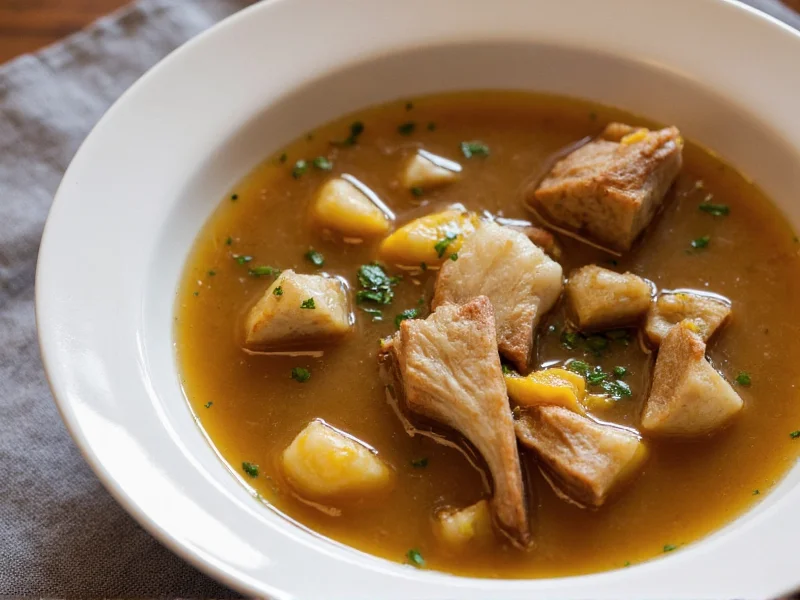Understanding Bone Marrow Broth Soup
Bone marrow broth soup represents an evolution of traditional bone broth preparation, with specific attention to preserving and incorporating the nutrient-rich marrow during the cooking process. While regular bone broth primarily extracts collagen and minerals from bones, bone marrow broth soup intentionally maintains the fatty marrow component, creating a more nutritionally complete product.
The key distinction lies in preparation methodology. Traditional bone broth often discards marrow after initial roasting, while authentic bone marrow broth soup retains this valuable component throughout the entire simmering process. This approach yields a richer, more complex flavor profile and significantly higher concentrations of certain nutrients found predominantly in the marrow itself.
Nutritional Profile and Potential Benefits
Bone marrow contains unique compounds not found in significant quantities in other broth components. The nutritional analysis of properly prepared bone marrow broth soup reveals:
| Nutrient | Concentration in Bone Marrow Broth | Primary Health Associations |
|---|---|---|
| Collagen | High (15-20g per cup) | Skin elasticity, joint health, gut lining integrity |
| Glycine | Significantly elevated | Detoxification support, sleep quality, tissue repair |
| Conjugated Linoleic Acid (CLA) | Moderate to high | Metabolic health, inflammation reduction |
| Vitamin A (retinol) | Naturally occurring | Immune function, vision health |
| Iron (heme form) | Present in marrow | Blood health, oxygen transport |
Research published in the Journal of Agricultural and Food Chemistry indicates that extended simmering (24-48 hours) significantly increases collagen extraction compared to shorter cooking times. However, scientists caution that while bone marrow broth soup shows promise for supporting connective tissue health, more rigorous human studies are needed to confirm many popular health claims.
Traditional Preparation Methodology
Authentic bone marrow broth soup preparation follows specific protocols developed through culinary tradition. The process differs from standard bone broth in several critical ways:
Ingredient Selection
Quality bones determine final broth quality. Optimal choices include:
- Fresh, pasture-raised beef or lamb femur bones (1-2 inches in diameter)
- Bones with visible marrow channels (avoid pre-drilled bones)
- Knuckle bones for additional collagen
- Organic vegetables for flavor complexity
Critical Temperature Control
Maintaining proper temperature throughout the cooking process proves essential for optimal nutrient extraction while preventing spoilage. The ideal temperature range remains between 160-180°F (71-82°C) - hot enough to extract nutrients but below boiling point to preserve delicate compounds.
Many home cooks make the mistake of boiling bone marrow broth soup vigorously, which emulsifies fats and creates a cloudy, bitter product. A gentle simmer with occasional skimming of impurities yields superior results.
Traditional Bone Marrow Broth Soup Recipe
This authentic preparation method follows time-tested techniques for maximum nutrient retention and flavor development:
Ingredients
- 4 pounds beef femur bones with marrow
- 2 tablespoons apple cider vinegar
- 1 large onion, quartered
- 2 carrots, roughly chopped
- 2 celery stalks, roughly chopped
- 4 garlic cloves, smashed
- 1 tablespoon whole black peppercorns
- 2 bay leaves
- Small bunch fresh parsley
- Filtered water (enough to cover bones)
Step-by-Step Preparation
- Preheat oven to 400°F (200°C). Arrange bones on a baking sheet and roast for 30 minutes until browned.
- Transfer bones to a large stockpot. Add vinegar and just enough water to cover - let sit for 30 minutes.
- Add all remaining ingredients except parsley. Fill with water to cover ingredients by 2 inches.
- Bring to a gentle simmer (do not boil), then reduce heat to maintain 160-180°F.
- Skim impurities during first hour of cooking. Add hot water as needed to keep bones covered.
- Simmer uncovered for 24-48 hours, maintaining consistent temperature.
- Add parsley during final 10 minutes of cooking.
- Strain through fine mesh sieve, pressing gently on solids to extract maximum liquid.
- Cool rapidly in ice bath, then refrigerate overnight to remove solidified fat layer.
Troubleshooting Common Issues
Even experienced cooks encounter challenges when preparing bone marrow broth soup. Understanding these common problems ensures success:
- Cloudy broth: Caused by boiling too vigorously. Maintain gentle simmer below 180°F.
- Bitter taste: Results from overcooking vegetables. Add vegetables during final 12 hours.
- Weak flavor: Insufficient roasting or cooking time. Roast bones until deeply browned.
- Excessive fat separation: Normal occurrence. Chill broth and remove solidified fat layer.
Incorporating Bone Marrow Broth Soup Into Your Diet
For optimal benefits, consider these evidence-based recommendations for consuming bone marrow broth soup:
Registered dietitians suggest consuming 8-12 ounces daily, preferably on an empty stomach to maximize nutrient absorption. The broth works particularly well as a base for soups and stews, though many prefer it simply heated with a pinch of sea salt.
Dietary considerations vary by individual needs:
- Paleo and keto diets: Naturally compliant with both dietary frameworks
- Autoimmune protocols: May require omitting nightshade vegetables
- Low-histamine diets: Shorter cooking times (12-18 hours) may be preferable
Storage guidelines ensure safety and quality preservation. Properly prepared bone marrow broth soup maintains quality for 5-7 days refrigerated or up to 6 months frozen. Always reheat to 165°F before consumption.
Addressing Common Misconceptions
Several persistent myths surround bone marrow broth soup preparation and benefits:
Myth: Bone marrow broth soup contains significant amounts of stem cells.
Reality: While bone marrow contains stem cells, the cooking process destroys these cellular structures. The nutritional value comes from broken-down components, not intact cells.
Myth: Longer cooking always yields better results.
Reality: Beyond 48 hours, diminishing returns occur with potential nutrient degradation. 24-36 hours represents the optimal window for most preparations.
Myth: All bone broth provides identical benefits.
Reality: Bone marrow broth soup specifically preserves the fatty marrow component, yielding different nutrient profiles compared to standard bone broth that discards marrow.











 浙公网安备
33010002000092号
浙公网安备
33010002000092号 浙B2-20120091-4
浙B2-20120091-4